Saturday, June 10, 2023
News and Views from the Global South
“This is not a country where you can dream.”
The shattered hopes of the Haitian people.
The shattered hopes of the Haitian people.
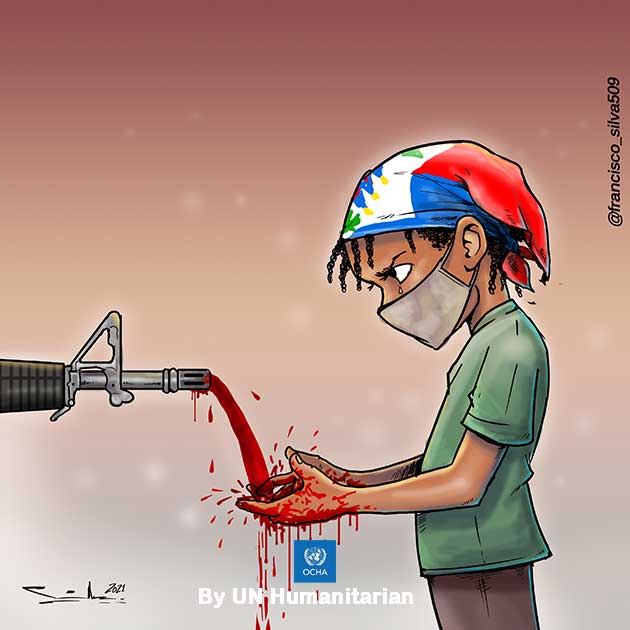
For millions of people in Haiti, life is a daily, terrifying struggle. Gangs use rape as a form of intimidation, children go to school hungry and in fear of stray bullets, and more than 5.2 million people need humanitarian assistance. The country’s dire situation is the result of three consecutive years of economic recession, a political impasse and unprecedented levels of gang violence.
Aid organizations working in the country gave a voice to some of the affected people by collecting nearly 200 testimonies and featuring them in the 2023 Humanitarian Needs Overview (HNO) for Haiti. Each testimony paints a harrowing picture of the country’s humanitarian situation.
Three Haitian artists, Silva Jean Francisco, Shneider Léon Hilaire and Oliga, agreed to contribute their artwork to the HNO. Each illustration, a testimony in its own right, sheds a unique light on Haitians’ daily lives.
Below is a selection of the testimonies and illustrations featured in the 2023 HNO.
Haiti’s entire population, 11.5 million people, are hostage to brutality and gang violence.
Since 2020, Haiti’s gangs have developed sophisticated tactics and formed powerful coalitions. They now encircle the metropolitan area of the capital, Port-au-Prince, and their clashes with the Haitian National Police have resulted in countless victims and a permanent climate of fear.
In the heart of Port-au-Prince, the infamous Cité Soleil commune illustrates the gangs’ power. Women and girls, as well as men, are raped and assaulted with indescribable violence. Gang rape is frequently used as a form of intimidation and to prevent resistance.
Here are just some of the heartbreaking stories of the many survivors.
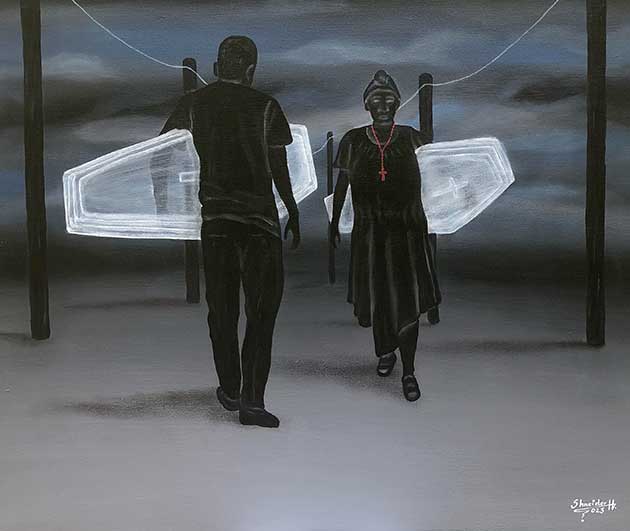
“Mache ak sèkèy Ou anba braw.” “Walking with his coffin under his arm. Acrylic on canvas. Copyright: Shneider Léon Hilaire”
A Woman recounts her terrifying experience:
“I was at home when I heard the sound of flying bullets outside. I started to run to escape, and that’s when a young man caught me. Despite my pleas, he would not let me go.
All the while, he continued to abuse me. I am the mother of 11 children, their father died the same day in the city. It was the first time I was sexually abused; it was terrifying.”
This type of violence happens daily, randomly and, unfortunately, sometimes repeatedly. A young girl explains:
“To tell you the truth, I was raped twice. The second time, it started on 14 July when my father was coming home from work. He was shot and burned in front of us. The next day, men came knocking on the door of the house where my two little brothers, my mother and I were staying. They threatened to burn the house down if we didn’t open the doors. I was wearing a dress when I went to open the door. They put me on the bed and abused me in front of my family, while beating them.”
Most survivors do not report their abusers, who enjoy de facto impunity due to the weakness of Haiti’s police and judicial system. They remain silent for fear of stigma or reprisals.
“I am young, I am ashamed of what happened. Even though many of us are going through the same thing, there are people who make fun of us because of what happened. We have no value in front of the young boys in the neighbourhood. This situation hurts me. I would like to get out of the area, I would like not to go through this situation again that I endure every day.”
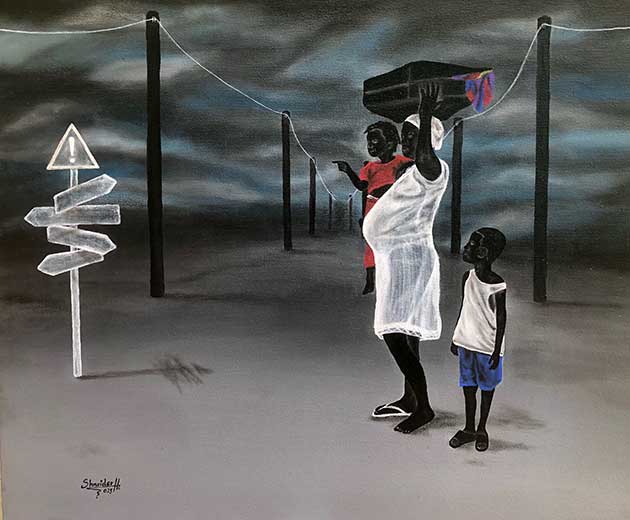
The Displaced. Acrylic on canvas. Copyright: Shneider Léon Hilaire
The violence causes many Haitians to flee, either just a few hundred metres from their home or several thousand kilometres away.
Fleeing for survival
Place Hugo Chavez was a spontaneous site in the capital’s metropolitan area that became a refuge for people fleeing violence, particularly in April and July 2022. Faced with an influx of hundreds of destitute households, but with no basic health infrastructure, living conditions at the site quickly became unbearable. Assistance from humanitarian organizations was critical to support Haitians forced to abandon their homes.
Christelle* fled the violence with her baby:
“My journey was very difficult. That day, many people were hit by bullets, and some died. The bandits kept shooting. God helped me to get through, and I managed to escape despite my pregnancy.”
Christelle lives in appalling conditions. She explains:
“We can’t have a normal life on the site, we don’t live well. Even with my pregnancy, I find it difficult to feed myself, and I fear that this will affect the health of my baby. People share with us what little they have, they are good neighbours but it is not enough.
“On the site, the quality of living conditions is not good, especially with the young men waging war with rocks, endangering my baby’s life. I live in the open air, I sleep with my baby, and when it rains I stand around waiting for the rain to stop, until the ground becomes dry again. Then I try to go back to sleep. We have access to some drinking water, and water for showering. The problem is where to take my bath, because it is in the open, in full view of everyone.”
Despite all this, Christelle does not regret her decision to leave:
“The impact is positive for me because the way I used to live in fear was worse, unbearable. Now I have some peace because I don’t hear the gunfire anymore. Where I lived before, I lost two brothers and the father of my child. You can’t do worse than that.”
Faced with deteriorating living conditions and daily violence, Christelle, like many Haitians, is considering building her future abroad:
“I don’t want to stay at the site, I don’t want to go home, but I want to find somewhere to live to raise my child, in the Dominican Republic. Or I would like to be able to lease a house in Maïs Gâtés, because I already have a cousin living in the area.”
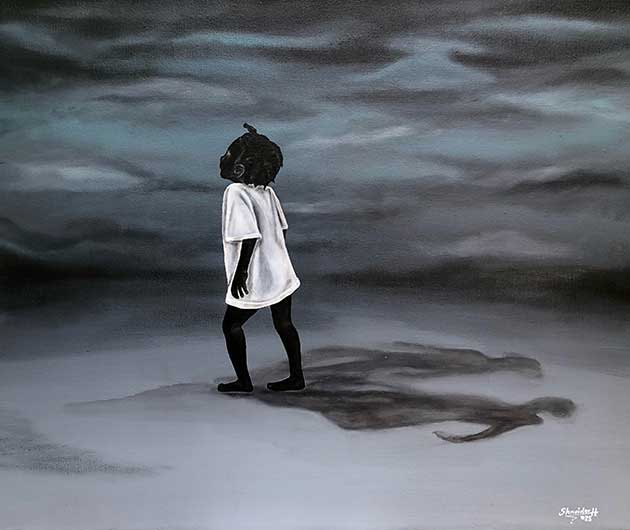
The neglected child. Acrylic on canvas. Copyright: Shneider Léon Hilaire
Every day, more and more people fall into extreme poverty; 31 per cent of the population lives on less than US$2.15 a day.
Bankruptcy or fire
In the neighbourhoods where they operate, gangs hold merchants and businesses to ransom, paralyzing the economy. Despite the constant fear of going out and losing their lives, Haitians’ motivation is still there, as is their desire to work.
John* says:
“It is a real destruction of the economic and social life of the people who live in these places. Someone who builds a house sees it burned down in a few days or occupied by gangs in strategic areas. For the hundreds of small businesses, there are two options: bankruptcy or fire.
“Those who remain are those who have no other option and no economic means to go and live elsewhere. We know that the whole country suffers from a lack of jobs and income, but here it is even worse. We just want to exchange the worst for the slightly less bad.
“There are so many people begging that the people who give are also the ones begging a street away.”
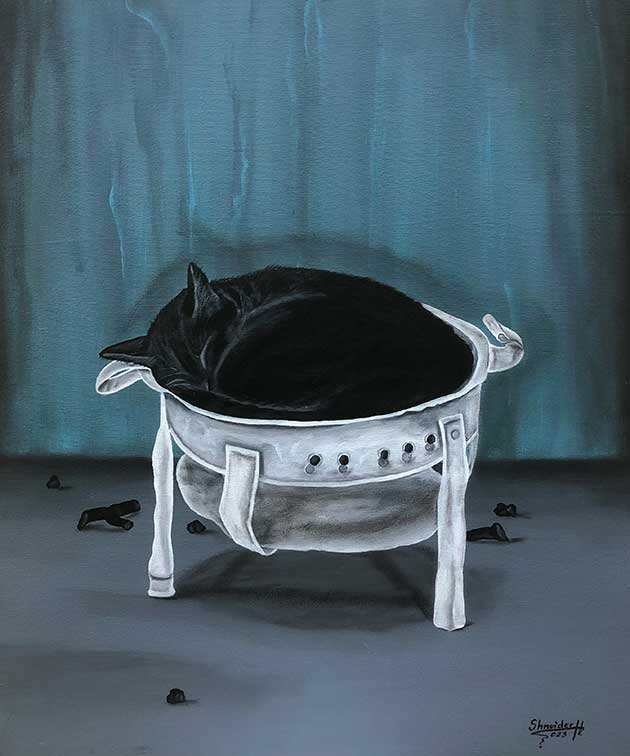
“Se Chat k ap dòmi nan rechom “. “The cat fell asleep on the stove Creole expression describing hunger and misery Acrylic on canvas. Copyright: Shneider Léon Hilaire”
There are 4.8 million food-insecure Haitians in 2023.
Watching your children starve
Haiti’s security situation is undermining its fragile economy. Price increases and the lack of income are causing the demand for goods to fall, which is damaging the economy. As a result, the most vulnerable people can no longer meet their nutritional needs.
Clément,* a single parent forced to flee violence, explains:
“My life is ruined; nothing works for me anymore. I have four children, of whom I am both the father and the mother.
“Because of the insecurity, I live with my sister who lives in a shelter with her husband and five children. It is very difficult for me because I don’t work. I am a merchant, but I don’t do anything to provide for my family.
“I ran away without money, without my goods, to save my children’s lives.
“There are almost all the products available on the market, but I can’t buy them. I look at my children, I don’t know when they will die of hunger.
“My biggest challenge is not being able to feed them and seeing my children who didn’t ask to be born.”
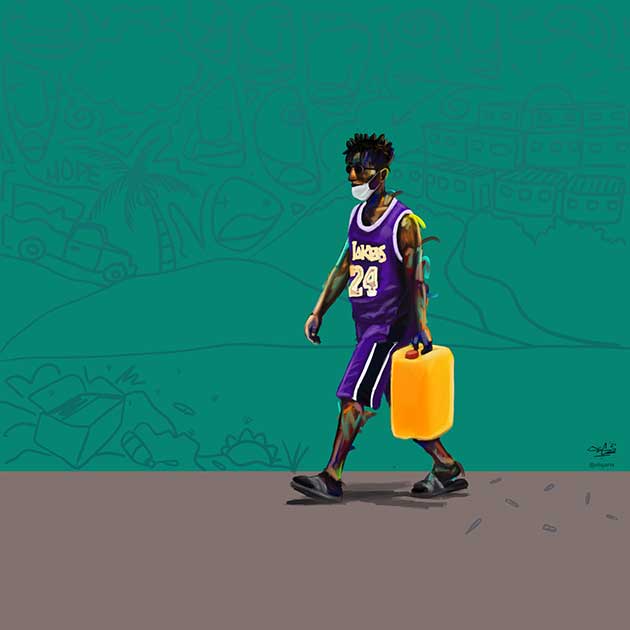
The pursuit of happyness. Copyright: Oliga
Health has become a privilege for Haitians, with almost a quarter of the population living more than an hour’s drive from first aid.
The scourge of cholera
Haiti’s deteriorating security and economic situation is a major barrier to accessing basic health services. After the Ministry of Public Health and Population confirmed two cholera cases in October 2022, the epidemic spread rapidly across the country; there were more than 22,000 suspected cases by the year’s end.
Chrismene’s* family, like so many others, has to cope with the disease while living in precarious sanitary conditions. She explains:
“My two-year-old was taken to hospital after giving me a big scare: She had diarrhoea and was vomiting all the time. I noticed it on Tuesday morning when I was preparing food. Everything was fine, but in the evening she was moving around. During the night I saw that her stomach was distended, so we decided to go to the doctor.”
Access to care is often complicated by the cost in private facilities and transport costs:
“When we arrived at the doctor’s, he told us that he could not take us without paying. So we rushed to a public hospital on a motorbike and borrowed 1,500 gourdes ($9.7) from a friend. When we arrived, they didn’t even have time to make a chart, so they gave her a serum. There was no bed, so I spent the day sitting on a bench, giving her the serum. The doctors took good care of her, I’m happy with what they did for her. Today the diarrhoea is still there, but the vomiting has stopped.”
Chrismene’s daughter seems to be out of the woods, but cholera could still strike her family. She knows that lack of access to water is a major factor in the spread of cholera in Haiti:
“A gallon of drinking water sells for 30 gourdes ($0.19). Sometimes I go all day without water because I have no money. Domestic water, on the other hand, is not so difficult to find, and it costs much less, 5 gourdes ($0.03) a bucket. Domestic water, for washing clothes, is not a problem for us. It is drinking water that is difficult. I am afraid that other people will drink the domestic water by default and get sick.”
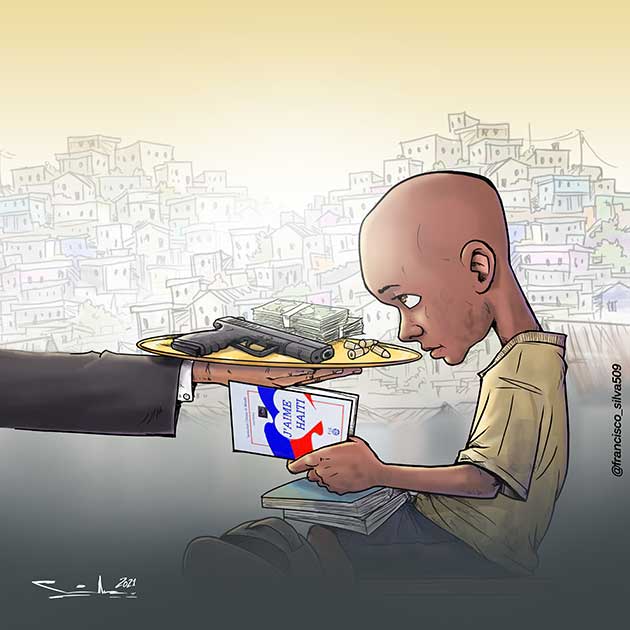
The manipulation of childhood. Digital illustration. Copyright: Francisco Silva
Only 20 per cent of Haiti’s schools are public, the rest are private, tuition based and unaffordable for most people.
Going to school with fear in your stomach
Children are among Haiti’s most vulnerable people. Parents want to see their children go to school and succeed, but many can no longer afford their education. In some gang-controlled neighbourhoods, students’ and teachers’ access to schools is impossible. The situation’s impact on Haiti’s future is alarming.
Rose,* a teacher at a school in Port-au-Prince, notes students’ growing dependence on school-feeding programmes:
“I think the meal is very important for the children, it really helps them. Sometimes they come without food, so we give them salt water so that they don’t faint. We always ask them if they had a meal before coming to school. Unfortunately, the answer is almost always no. It’s so rare to get a positive answer that when it happens, we talk about it among the teachers.”
Rose also talks about her fear of walking to school:
“Well, in the last few months, Port-au-Prince has been very difficult for us. Difficult in the sense that you have to go out as a teacher, but you are afraid. It is not normal to go to work with fear in your stomach. It’s the same for the pupils and even the parents.
“Parents are afraid to send their children to school in the morning and not see them again in the evening.
“There is shooting everywhere, all the time. Sometimes you don’t know where the bullets will come from. You can get a bullet in the schoolyard or in a classroom, because when they [the gangs] shoot, the bullets have no direction. Because of the shooting, the children are no longer able to concentrate in class.”
These testimonies are just a small reflection of the dire situation that Haitian people face every day. The 2023 Humanitarian Needs Profile for Haiti provides a more comprehensive view of the country’s dynamics through additional testimonies and in-depth analyses of the humanitarian context.
*All names have been changed.


